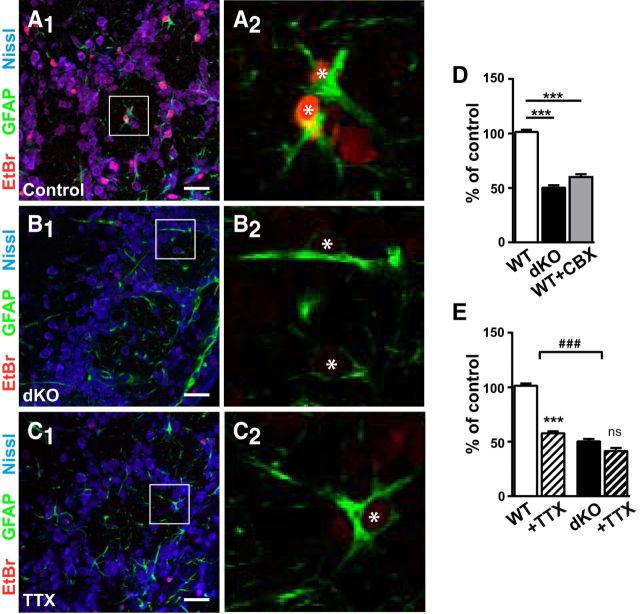Figure 4.
Spontaneous neuronal activity promotes astroglial connexin-formed hemichannels opening in the olfactory bulb glomerular layer. Hemichannel activity was assessed by ethidium bromide (red) uptake assays. A1–C2, Astrocytes (asterisks) are identified by GFAP immunoreactivity (green), and Nissl (blue) is used as a counterstaining. Higher magnifications are shown in the right panels corresponding to the areas delimited by white squares in the left panels. EtBr fluorescence in astrocytes is reduced by deletion of Cx30 and Cx43 (dKO; B1, B2) and by TTX application (C1, C2). Scale bars, 25 μm. D, EtBr uptake is reduced by Cx deletion (50.4% inhibition) and application of CBX (40.8%; 100 μm; n = 682, 356, and 201 cells in control, dKO, and CBX conditions, respectively; one way ANOVA, p < 0.001; post hoc Tukey's multiple comparison test, ***p < 0.001). Note that EtBr uptakes in dKO and CBX conditions are not significantly different. For each condition, fluorescence values are expressed as a function of the mean fluorescence value obtained in the WT control condition of each assay (see Materials and Methods). E, EtBr uptake is reduced by 43.1% when spontaneous neuronal activity is inhibited by TTX in the WT (one way ANOVA, p < 0.001; post hoc Tukey's multiple comparison test, ***p < 0.001), but not in absence of astroglial Cxs (dKO). The effect of TTX treatment in the dKO is significantly reduced compared to WT (two-way ANOVA, ###p < 0.001 for the interaction). Note that EtBr uptake values in WT + TTX and dKO conditions are not significantly different.

